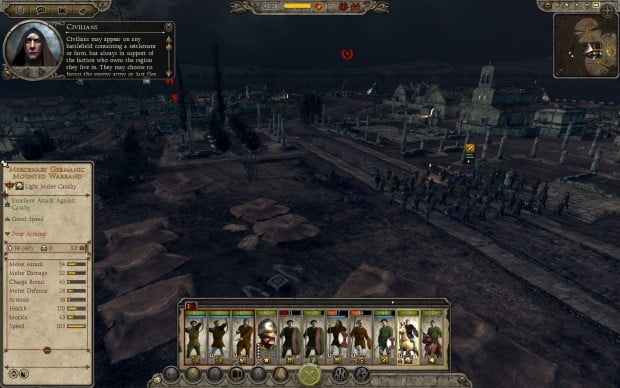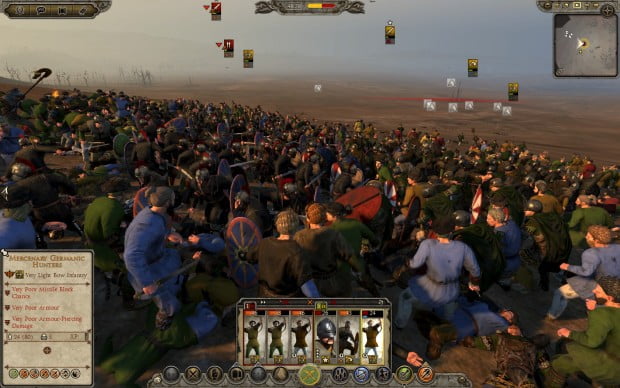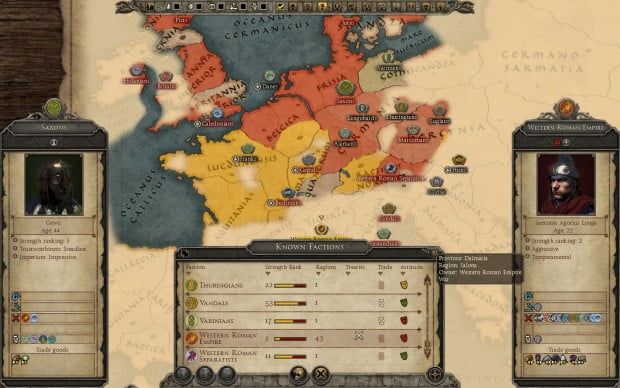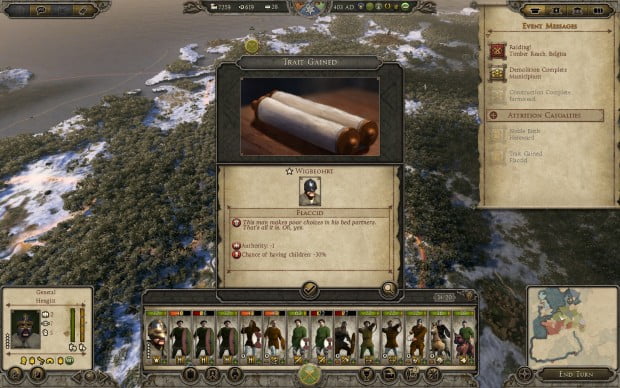Developer: Creative Assembly
Publisher: SEGA
Platform: PC (Steam)
Review Copy Provided By: SEGA
Release Date: February 17, 2015
To better understand Total War: Attila’s strengths and weaknesses, it helps to understand what the Total War series does so well, and where its games have lapsed somewhat in the last few years. For me, the series was at its best around the original Rome: Total War and its follow up Medieval II: Total War. Those games excelled at masking a deep and somewhat complex strategy game behind some easy to understand prompts, icons and menus, with the added bonus of some wonderfully cathartic real time combat to enjoy when the resource management and strategic positioning was getting a little dull. It was the little things, then, that disappointed me about Rome II, rather than any one major change. These changes marked a different direction in the series, one of greater historical accuracy at the cost of satisfying gameplay feedback, and one that Attila has continued with. Fortunately, Attila also brings back a lot of the simple design techniques and UI features that made older Total War games so easy to master.
Set in the dark ages, Attila charts the fall of the Roman Empire, the uprising of many European tribes, and the invasion of the Hunnic hordes. In many ways, it acts as a sort of extended epilogue to Rome II, though I don’t mean that disparagingly – if its precursor was all about conquering and dominating foes, Attila is far more concerned with the player surviving and thriving against the odds, a theme which is summarized rather well within the game’s Gothic prologue. The prologue does a fine job of easing you into the systems in play, while also preparing you for a lengthy and somewhat arduous campaign, one wherein enemies approach from all sides, plague, pestilence and famine wear away Empires, and alliances are uneasy at best. In fact, Attila so adeptly crafts an atmosphere of tension, danger and foreboding, one has to wonder whether developing Alien Isolation has affected the way Creative Assembly approaches its darling strategy series.

As usual, Attila is divided into two key parts: strategic movement and resource management takes place on the game’s tactical map, while real time battles take place on individual land, naval or coastal battlefields. Once again, the latter of these two elements proves to be the game’s greatest strength. Real time battles are intense, surprising and full of tactical choices – easy to grasp, but difficult to master. Creative Assembly has clearly paid great attention to detail when crafting towns, cities and battlefields, as each one feels like an occupied, dynamic world filled with destructible trees, buildings, barriers, and even fleeing peasants who occasionally get embroiled in battle themselves. These battles, no matter how small, are almost always tense, exhilarating exercises in quick thinking, smart strategizing, and sheer force of will.
Attila also does away with one of Rome II niggling problems, by once again replacing unit cards with 3-D models of the units, rather than Rome II’s pesky, unreadable cards. This makes it a damn sight easier to determine who is whom on both the battlefield and the campaign map, as do helpful icons which indicate if a unit is a spearman, pikeman, archer etc.

A few too many of Rome II‘s issues still remain on the campaign map, however. Though efforts has been made to strip down the game’s UI and make it easier to digest (as it was in older Total War titles), many elements of the campaign map are difficult to comprehend. Some icons feel confusing and unhelpful, and though the game always tries to help you on your way, on several occasions its instructions merely left me with more questions than answers. One must build sanitation buildings in cities in order to prevent disease from culminating/spreading, but once the disease hits the game’s advice on how to deal with it is, rather unhelpfully, to “pray”. This all helps to enhance Attila‘s oppressive atmosphere, but it also renders proceedings feeling somewhat unfair or undercooked. Once you get past this early learning stage, the game finds its stride quite comfortably, but the less patient of us might be inclined to bow out during what can be an arduous early-game.
Regions are still governed on a province-wide basis – a system that only serves to make micromanagement harder – and the game’s political and diplomatic systems remain obtuse and frustrating at the best of times. Most of the time, factions will make decisions that benefit them and their allies, but occasionally they make nonsensical decisions or remain relatively idle on the campaign map. Far too often did I watch great and powerful nations opt to simply sail around for years on end instead of sending their armies to battle Rome, the world’s common enemy.

Attila regularly throws The Sims style pop-ups your way which force your leader into making political decisions. These usually amount to deciding whether a governor/general is allowed to marry/move up in office, but the game only ever gives you two choices to make, both of which are negative, and it never takes into account alternative reasons for not wanting a general to marry, just the game’s systemic, statistical valuations of “power” and “control”. All of this feels like a well meaning but poorly executed attempt to ape the complexity of Crusader Kings II, when that’s not really what Total War has ever been “about.”
It must be said, too, that Attila is somewhat damaged by its choice in historical period. By doubling down on historical accuracy and providing a welcome attention to detail in regards to faction banners/positions/colours, things feel somehow less iconic and meaningful. I know this is partly a fault with players, myself included, but when fighting the Egyptians in Rome: Total War, it had a certain a gravitas: “Oh crap! The Egyptians are coming!” The same cannot be said of witnessing 50+ interchangeable European tribes battling, most of which possess similar units, carry similar banners, and operate under varying shades of green. Though witnessing and taking part in Attila‘s ever-evolving political and military landscape is generally satisfying, its trappings will only feel significant to fervent history buffs. Outside of the Romans, the Saxons, the Huns and a handful of others, most factions are unrecognisable to the average human being, which makes it all the more frustrating to be forced to watch them accomplish the bare minimum of tactical movement for upwards of a minute between turns.

That’s not to say Attila‘s campaign is anything close to poor. If you’ve ever enjoyed a Total War game before, that feeling of engaging, stripped-back empire management is still present at the game’s core, and the addition of hordes as nomadic, barbaric factions who exist to roam and pillage until they find a new home is a welcome and intriguing development for the series.
Attila also manages to be one of the best looking strategy games on the market, and the aforementioned inclusion of more dynamic elements within the world only serves to accentuate that Creative Assembly are at the top of their game when it comes to building realistic strategy maps.

Though I’m being rather harsh on Attila, it’s only because Total War as a series has achieved a relatively consistent quality over the course of fifteen years, and it’s much easier to focus on the things the series gets wrong than those it gets right. Attila demonstrates that Total War is unparalleled when it comes to creating expansive, thrilling battlegrounds, and though it’s hardly flawless, the majority of its campaign gameplay is still engrossing. As with Rome II, though, Attila lacks somewhat when it comes to delivering satisfying levels of feedback; the stakes don’t feel as high as they were in Rome, Medieval or Empire, though Attila‘s ability to create a sense of fear and despair in the player is a welcome enough addition to the series to make Creative Assembly’s latest effort feel like more than just an add-on.
Review Overview
Score:
3.5/5
Though many of Rome II's warts still show, preventing it from reaching the heights of older Total War games, Attila is still a worthy addition to the series, not least because it's the first to present a completely different side to war: one of darkness, despair and destitution. Its political and diplomatic features are still fluffy and unreliable, and AI is still inconsistent, but Attila retains enough classic Total War goodness to make it a thoroughly enjoyable, almost excellent slice of historical strategy gaming.